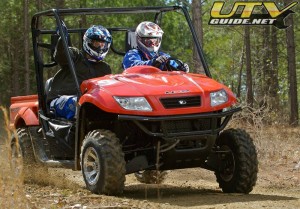Taiwan’s Powersport Industry in the Eyes of Magazine Journalists
The organizer of the 4th Taiwan International Motorcycle Industry Show (Motorcycle Taiwan 2009), held April 14-19, 2009 at the Taipei World Trade Center, Taiwan External Trade Development Council (TAITRA) invited several globally renowned journalists covering the powersport industry to see the latest in the island’s powered two-wheeler (PTW), all terrain vehicle (ATV), and light electric vehicle (LEV) sectors.
Some of the journalists were in Taipei the first time but have heard of, and seen Taiwan-made powersport products; while some were invited for the second time, due to their professionalism and popularity of their publications.
Generally all the invited journalists were highly impressed by the local powersport industry and its rapid advancement in the past few years. On the other hand, there was an overwhelming consensus that made-in-Taiwan and Taiwanese brands in the powersport industry trigger barely a blip on the global consumer radar.
One obvious, significant progress made to attract the journalists’ attention is the rapid development of bigger-displacement powertrains for PTWs and ATVs in the past few years. Around three years ago these were mainly limited to under-250cc units but now some local PTW/ATV makers have commercialized bigger, self-developed engines: Taiwan Golden Bee (TGB), Advance Power Investment Co., Ltd. and CECTEK have launched 500cc vehicles; Sanyang Industry Co., Ltd. has introduced 600cc versions; Kwang Yang Motor Co., Ltd. has unveiled 700cc products. Several PTW makers are also developing high-efficiency engines for big-bore PTWs, ATVs, and even mini cars. Such scenario, according to the foreign journalists, show the island`s considerable technical capability and, more importantly, motivation and strength to compete directly against bigger, globally famous brands in the increasingly crowded market.
The foreign journalists were also struck by the number and sophistication of local LEV makers, including lithium-ion battery makers, power management system (PMS) solution providers, assembled-vehicle producers, propulsion/drive-train suppliers etc.
The following sums up the comments made by the foreign reporters during interviews at the Motorcycle Taiwan 2009.
Taiwan-made high-quality ATVs should be differentiated from lower-end counterparts.
American Perspective
Specializing in off-road powersports, Dennis Cox, senior editor of Dirt Wheels, recognized as a leading ATV magazine worldwide, was impressed with the quality, innovation, and performance of Taiwan-made ATVs in the big-displacement segment.
“Though the quality is high and the prices are very reasonable,” Cox continues, “I think Taiwanese ATV makers lack really successful marketing and branding works in the big U.S. market. One example is that vehicles made by TGB are so competitive all-round, but most of the key distributors on the West Coast do not know the brand.”
Race as Proof
Cox’s first suggestion to Taiwanese ATV makers who want to establish own-brand sales in the U.S. is to race and prove themselves. “I recommend Taiwanese ATV brands to participate in more races in the U.S. to prove their outstanding machines by competing in 24-hour endurance races.” “Winning these races offers real evidence for the quality, durability and reliability of machines. This is important because not long ago, most American consumers did not know the difference between Made-in-Taiwan and Made-in-China powersport products, believing they were of the same quality. Through big distribution channels, China-made ATVs have been selling in big-volumes in the U.S. over the past few years, but rarely do Americans make second purchases due to quality and functions.”
Without a doubt, now is the best time to promote Taiwan-made ATVs in the U.S. thanks to the “double effect,” with the image of made-in-China vehicles worsening in the minds of both consumers and distributors, and that of made-in-Taiwan rapidly improving, especially when major Taiwanese brands as KYMCO, TGB, SYM etc. have been aggressively marketing with quality products and big investments, Cox says.
Differentiate From Chinese
Another of Cox’s suggestions is to step up marketing.
“Major appeals in Taiwanese ATV or PTW makers` marketing strategy should tell American consumers and distributors why they`re different from general Chinese rivals, as well as why they are good enough to compete directly with Japan-made models,” Cox suggests. “In addition, I think for better marketing effects Taiwanese brands should provide longer warranty to highlight the quality issue, as well as put more resources on nation-wide advertisements as what KYMCO has done.”
The senior editor also reminds Taiwanese companies of the growing utility vehicle market in the U.S., and the need for more lower-prices but good quality products with compact-size and good-functionality for farming, construction etc. “But a good sport quad does help sell other kinds of vehicles under the same brand,” Cox says.
UTV is Growing
“The UTV (utility vehicle or side-by-side) sector is the only segment growing in the off-road vehicle market in the U.S. in recent years and is expected to grow continually over the next several years,” Cox adds. “Taiwan should try to be an important player in the growing business because makers on the island are quite famous with their quality level.”
“Vehicles with hybrid propulsion systems are another focus in the American off-road vehicle market,” Cox adds, “not only because of the fuel-saving concerns but also the practicality of such vehicles.” Especially in hunting applications, Cox explains, “when you sneak up on an animal you can not make noise, so when your vehicle shifts into electric mode you get the propulsion power, speed, and needed quietness.”
“In my opinion, Taiwanese companies with strong design, development and manufacturing capabilities can do much more than what they are doing now,” Cox says. “For example, you have powerful engines, good manufacturing techniques, globally famous small-batch, large-variety production flexibility etc., the custom-bike market in the U.S. should clearly offer great opportunities. But remember, only the best and first can get great rewards.”
The veteran editor says that the whole powersport industry has been rapidly transforming and only adaptable, cutting-edge players can survive. Even the media in the powersport industry is changing. “I anticipate that the new-generation magazine will soon come out with video contents,” he says.
Italian Viewpoint
Italy has been one of the most important PTW production nations filled with many international brands of unmatched creativity and engineering technologies, as well as being the largest PTW market in Europe, especially for high-end motorcycles and scooters. Reporting on such advanced industry is the Motociclismo magazine, the one with the longest-history, most professional, largest, and most profitable PTW magazine in Italy.
Christian Cavaciuti, technical editor of Motociclismo and a veteran industry expert with a Ph.D. in engineering, was on his second visit to Motorcycle Taiwan 2009. He has been interested in Taiwan`s PTW line, not so much in the technical stuff for the island’s PTW products still take a backseat to their Italian counterparts, but in the business strategy and technology advancement at some Taiwanese companies.
In a sweeping suggestion, Cavaciuti says: “Any company should pay attention to what the market really needs and wants rather than develop products intuitively, which often betrays the market demand.”
The most obvious example consists of Italian PTW makers, Cavaciuti says, most of which do not really understand the actual needs of foreign markets and launch high-end models priced prohibitively. Piaggio of Italy, the largest PTW maker in Europe, is one of the few paying attention to overseas markets, and still the firm lags major Japanese rivals, he says.
Taiwan Not on Consumer Map
“I am glad to see that most Taiwanese PTW makers, as KYMCO and SYM, are much more flexible and market sensitive, so some of them have achieved good sales in overseas markets, and they often catch what foreign customers want and respond immediately to such demands,” Cavaciuti furthers. “But the major problem is most consumers worldwide are strangers to the made-in-Taiwan image, which always keeps prices modest and limit sales in major markets.”
Few people know about “Asia`s Four Little Dragons”, the location of Taiwan, or the role of the small island, the editor says objectively. “Without much knowledge about Taiwan, consumers can expect only low-cost products from the island and won`t believe in the range of expertise available in its companies.”
Promote Quality
“Taiwanese companies should more aggressively promote their high quality globally, and their products, in many cases, which are not inferior to Japanese big names,” Cavaciuti says. “Marketing is so important in business, and country marketing is even more important to achieve much-better sales.”
Taiwanese PTW makers should step up marketing efforts because time is of the essence, he explains, as more and more Chinese rivals are winning increasingly higher market shares with European designs, great marketing and superior image. For example, “In Italy, many consumers assume KYMCO is a Korean brand because of the first world ‘K’, which shows lack of marketing insight.”
Each market has its own tendency, Cavaciuti states, and the Italian market tends to have consumers who prioritize styling over quality. In other words, PTW makers` profit margins rely more on successful styling design rather than quality only.
“So, if Taiwanese companies want to more successfully tap the Italian PTW market, the first thing is to establish brand names with stylish products,” he adds. “Or, you can succeed by offering acceptable styling but at good prices. The best example in recent years in the Italian PTW market is KYMCO`s X-citing luxury scooter with engines from 250cc to 500cc.”
Cavaciuti praises KYMCO’s X-citing luxury scooter from Taiwan as successfully offering acceptable styling at good prices in Italy.
High LEV Potential
“Taiwan is also an ideal place to develop LEVs because of its strong battery, electrical machinery, semi-conductor and vehicle-making industries. But still, Taiwan has to first shape an international image of good quality and price,” Cavaciuti explains. “I called upon several key players in the local LEV industry and found that the island has the ability to build the world`s best LEV of the highest quality at most competitive prices,” he says, “but the key is let people know the LEVs are from Taiwan. National image is critical. All industry insiders know Taiwanese companies supply a lot of high-end, key parts to legendary motorbike brands as Ducati, Truimph etc., an achievement that has to become common knowledge among more people.”
Source: http://news.cens.com/cens/html/en/news/news_inner_29716.html
Follow UTV Weekly on Twitter at: http://twitter.com/utvweekly
Get the Week in Review – Join Our Newsletter
Category: Kymco








